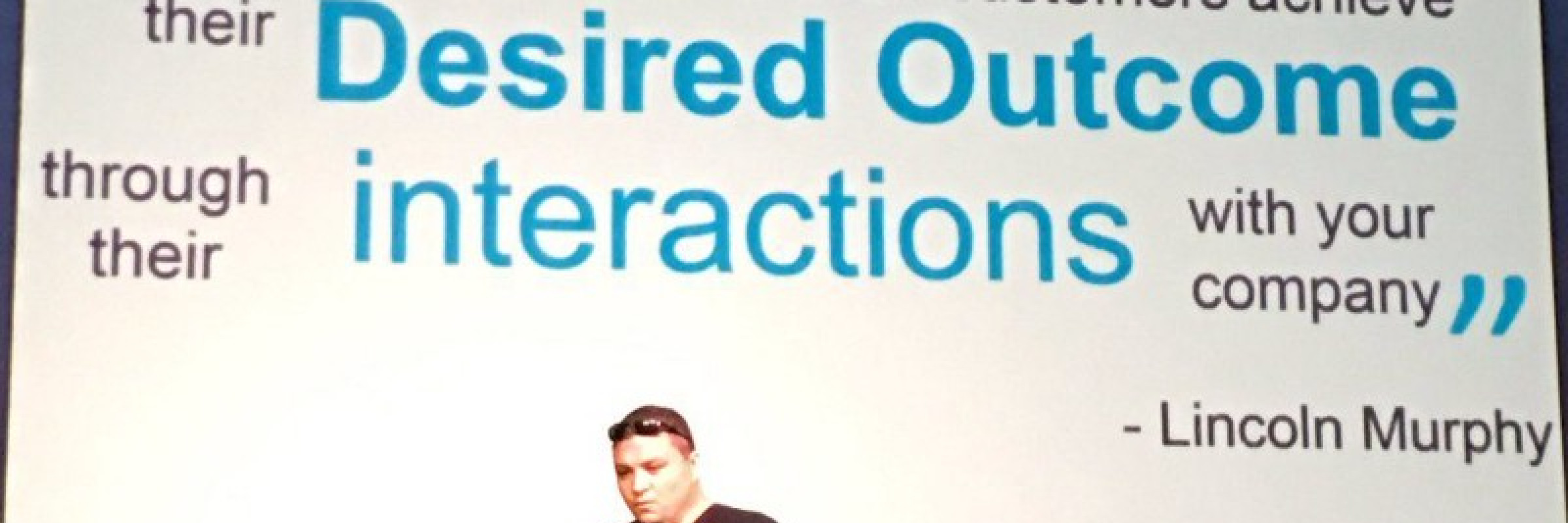5 ways to accelerate sales with customer success | Lincoln Murphy


By Pardeep
This is a summary transcript of Lincoln Murphy’s great talk at a sales acceleration summit.
The 5 key points covered
Identifying your ideal customer
Learning their desired outcome
Entering the conversation
Cloning your best customers
Lincoln’s dirty little secret
1. Identify your ideal customer
First of all we need to identify your ideal customer now. The ideal customer profile has several inputs: Ready, willing, able
Customers that are:
Ready to make a change
Willing to put in the effort
Able to put in the money
Most people stop here. We ask who’s your ideal customer? You tend to just say anybody who’s ready and able and of course that’s oftentimes a huge addressable market and ultimately not very targeted.
Before we go any further though I want to talk about something that’s really important, it’s situational awareness.
Situational awareness
It’s not ‘hey who’s your ideal customer forever,’ you know? Really this is about a situation and the situation has a definition which is two-fold.
- It has a goal.
- It has a timeframe.
So if I’m going to develop an ideal customer I’m going to do so with a particular goal in mind and for a particular time frame.
Maybe it’s for the next 90 days I want to get more more customers. You know I want to get 10 new customers in the next 90 days. In the next six months I want to add a hundred thousand dollars in ARR or I want to add a million dollars in ARR or whatever. Maybe it’s in the next six months I want to add 10 new customer advocates right? People that’ll go out and speak on our behalf or whatever. Whatever your goal is, be specific about it and then have a specific time frame for it and that’s the situation.
Once you have the situation you come back and you say ‘okay well I’m going to develop that ideal customer for the situation’ and just doing that changes even the ready willing and able inputs. It changes who we might go after but there’s also these other four inputs which are really important.
The four other inputs that are important
- Success potential
- Acquisition efficiency
- Expansion potential
- Advocacy potential
Success potential.
This is really simple. If you’re a product like Gainsight that is a Salesforce native product it would be, I would say a little bit foolish, to go after customers and market and try to sell to customers that don’t already use Salesforce.
It doesn’t mean if somebody comes to us and says hey I use a different CRM I would like to you know try to use your product. We might still talk to them but there would be caveats and a lot of warnings and a lot of like ‘this is not ideal’ but we wouldn’t spend a lot of time so we might end up working with them if it’s a win-win for everybody but we’re probably not going to go out and market directly to people and try to reach out to people that aren’t using Salesforce.
That’s the ‘success potential’ at a technical level. We look back at our data and some companies didn’t find success with our product. They just weren’t a great fit for us so at the very least you we want to figure out who isn’t our ideal customer.
We’ll also say these other customers were successful and here are the characteristics they share and we want to go get more customers like those.
Acquisition efficiency.
We all know this there are some customers that are easier to reach and faster to close so, if your situation is in the next 90 days we want to add 10 new customers then don’t go after customers that have 120 day sale cycle right?
If you’re trying to get customers in the next 90 days we really have to understand the acquisition efficiency as well and the way that you know the weight applied to these inputs depends on what your situation is. Again, if your board of directors want you know why your churns too high, we want more customers with more success potential basically, then your gonna weight that a lot heavier
If they say we don’t care about that, which is probably a bad way to do it, (not too many boards of directors would say that these days and if they do you should challenge them because that’s not cool) but they might say look I don’t care about success I just want more paying customers of any kind then you know acquisition efficiency might be one of the inputs that you weigh heavier.
Expansion potential.
Maybe a board says look, you know we have a departmental product here that you can sell into the marketing department of companies of all shapes and sizes but we know that to make us more valuable to acquisition targets we want to have more customers that have expansion potential. You’ve sold into marketing but other departments within the organization could could actually use it and so we want more of those types of customers on the books because potential acquirers might say that’s a lot more valuable, so that you know the ability to sell more of your product internally whether upsells cross cells are just expanding their use.
Advocacy potential.
I want more customer that can be brand advocates for me and that go out and do testimonials and speak at my events and stuff, well I probably also going to weight the success potential kind of heavy because people who aren’t successful with your product aren’t achieving their desired outcome probably. They’re not going to be your advocate for you but I also want to make sure that these types of companies have the ability to be advocates. Maybe a good sanity check here is, you know don’t if this is an input that’s really important to you then don’t go after customers that can’t be advocates like government contractors that can’t even admit that they exist right? They’re probably not going to be an advocate for you.
So the proper order of all of this just so you have an understanding is:
A. We want to develop that ideal customer profile
B. Then you start doing things like persona development empathy mapping
C. Then figuring out happening to what types of distribution and what types of outreach to use.
A lot of times we start with personas and marketing and in sales will say “I am going to sell to the CMO” or something but the CMO of a fortune 500 company is very different than the CMO of a start-up and so you have to first start with that ideal customer profile.
I believe this to be true, this is basically the thesis for everything that I’m saying today you can’t really know what pitch pricing or messaging or really lots of other things to use until you are clear on your ideal customer profile. Ultimately this is what’s going to help you qualify the company, not the contact that you know in sales. We oftentimes will talk to somebody they say ‘no they don’t have Bant’ or whatever it is and they were kind of like ‘okay we’ll move on’ but if we know that this company that is in our ideal customer profile, they fit that profile, then we’re going to go find somebody else there because we know that they are in fact qualified. They are ideal customer it’s just that person is sort of standing in our way.
2. Learn their desired outcome
The next thing is is we have to understand their desired outcome. I know this is really ‘how does customer success help you really accelerate your sales’ well, customer success is helping your customers achieve their desired outcome through the use of your product which it is.
The desired outcome by the way consists of two parts:
- Required outcome.
- Appropriate experience.
My example is always flying commercially in the US. I want to get someplace fast and safe, I can do that with just about every carrier but my experience, my appropriate experience, is with Virgin America. Somebody else’s might be Spirit airlines I’m probably not going to feel like I was successful if I flew on Spirit Airlines right? I’m not going to have that great feeling of success.
Desired outcome is really important to understand. It has both required outcome and appropriate experience and that’s critical to understand. It’s also critical to understand that bringing together your ideal customer profile and there it is and their desired outcome is sales rocket fuel, it absolutely is, and one of the reasons why it is, is because it allows you to enter the conversation
3. Enter the conversation.
Enter the conversation already taking place in your customers mind. A great salesman, one of the best ever said that. He happened to say that in 1937 and it was mostly in his experience from the early nineteen hundreds in late eighteen hundreds. It’s still and actually I think even more true today and if we say that success is really their desired outcome then the topic of the conversation, that’s in their mind, is their desired outcome.
That’s the main thing but it’s good to understand that there’s a desired outcome for the company and a desired outcome for the personas and they might not be the same.
The desired outcome for the company you know is ROI or success, monetary success, market share or whatever. In a small business the people might share that and you can talk about those things in your outreach emails, in your sales conversations, in a more emotionally charged way that ties directly to the success of the company. In a larger company the people you’re talking to may be disconnected from the success of the company in those types of ways and so you have to be aware of that.
4. Clone your best customers.
This is really simple. Go into your customer success product like Gainsight and figure out who your most successful customers are, the ones with the highest customer health score, highest customer lifetime value, or the companies that grew their lifetime value the most over their time with you. Go find more customers just like them, that’s the simplest way you can use customer success to accelerate sales. All this other stuff notwithstanding that’s amazing.
5. My dirty little secret.
Ugly designs and bad sales copy in your emails and a poor sales processes and all of that stuff? The dirty little secret is this, if you understand your ideal customer profile and you understand what their desired outcome is, you’re not going to have to do things as polished and as buttoned up as as you might. You will still find a lot of success and that’s kind of the dirty little secret.
Upscope would like to add our own dirty little secret for anyone using live chat tools whether it’s Intercom, Drift, Olark, Livechatinc or some other tool.
It is possible to remotely guide even your toughest and most confused customers from sign up to purchase and beyond in one click from live chat. Co-browsing aka screen sharing 2.0 is the future. Get Upscope co-browsing.
We hope you enjoyed our summary of the video ?

What to read next?


Continue reading the blog

